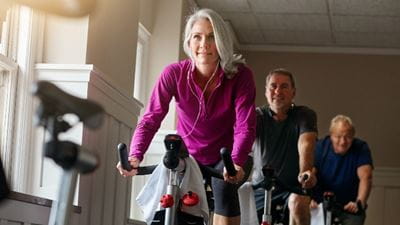Take Charge of Your Heart Health with Exercise
Physical activity benefits your heart in a variety of ways. Exercise improves circulation, which can help reduce the risk of cardiovascular disease. It improves blood cholesterol levels by increasing HDL (good cholesterol) and decreasing the amount of triglycerides in the bloodstream. It can help lower blood pressure, aid in quitting smoking and help control weight to eliminate obesity. If you have diabetes, exercise can help regulate blood glucose levels by improving the body’s insulin sensitivity.
Cardiovascular or aerobic exercises typically provide the most benefits to the heart because those activities increase the heart rate, promote more oxygen availability and strengthen the heart muscle. Exercises like walking, running, biking, swimming and dancing are excellent examples of cardiovascular exercise.
How Much Exercise Do I Need? 
Thirty minutes of cardio most days of the week is a good rule of thumb to reach optimal health. At the other end of the scale, too much exercise can be harmful to your heart.
The American Heart Association recommends 150 to 300 minutes of moderate- to high-intensity cardiovascular (aerobic) activity per week, along with 2 to 3 sessions of resistance training per week. Resistance training includes using light weights, resistance bands and resistance equipment (like a total body circuit).
But if you can’t work in 30 minutes per day, any activity is better than none, and the best exercises are the ones you enjoy and will do.Before starting an exercise program, it’s important to talk with your doctor to determine if exercise is safe. It also is important to set realistic expectations with a gradual increase in intensity and time. Talking with a personal trainer is a good idea, too, because they can provide tips on how to calculate your target heart rate and how to determine what levels are safe for you.
Your body will usually let you know if you’re going beyond a safe level. Shortness of breath, chest pain, dizziness/lightheadedness, palpitations and/or headache are some signs that the load is too much and should be adjusted.
Incorporating Physical Activity in Your Life
Not everyone looks forward to going to a gym for a hard workout, but physical activity doesn’t have to take place in a gym or at a prescribed time. Even for the most time-challenged people, exercise can be built into daily activities. Here are 10 easy ways to add more activity to your day:
- Use the stairs instead of the elevator.
- Park far away from where you are going so that there is more distance to walk. If possible, walk or ride a bike to run errands instead of driving.
- Wash the car or do some housework or yard work.
- Walk the dog or take a walk with your family
- Take a walk on your lunch break if you have time.
- Sign up for a dance class or join a nearby gym.
- Take a bike ride with a friend.
- Sign up for a 5K on the weekend.
- Join a local sports team or league.
- Start the day with a good stretch and end the day with calming yoga.
More Ways to Help Your Heart
In addition to exercise, these lifestyle changes can benefit your heart.
- Maintaining a healthy weight
- Eating a nutritious diet
- Staying away from smoking and secondhand smoke
- Keeping your blood pressure under control
- Using healthy coping methods to handle stress
- Keeping control of blood glucose levels if you’re diabetic
- Having regular check-ups with your doctor
Physical activity does not have to be a grind. And it doesn’t have to be a separate part of your life. Looking for ways to move more throughout your day and finding activities you like doing will help you take charge of your heart health while you enjoy the process.
Choose a Healthy Heart
In matters of the heart, speed and experience count. Which is why we’re excited to be the first hospital in Lake County to receive accreditation for our Chest Pain Center from the Society of Cardiovascular Patient Care.
Learn more





